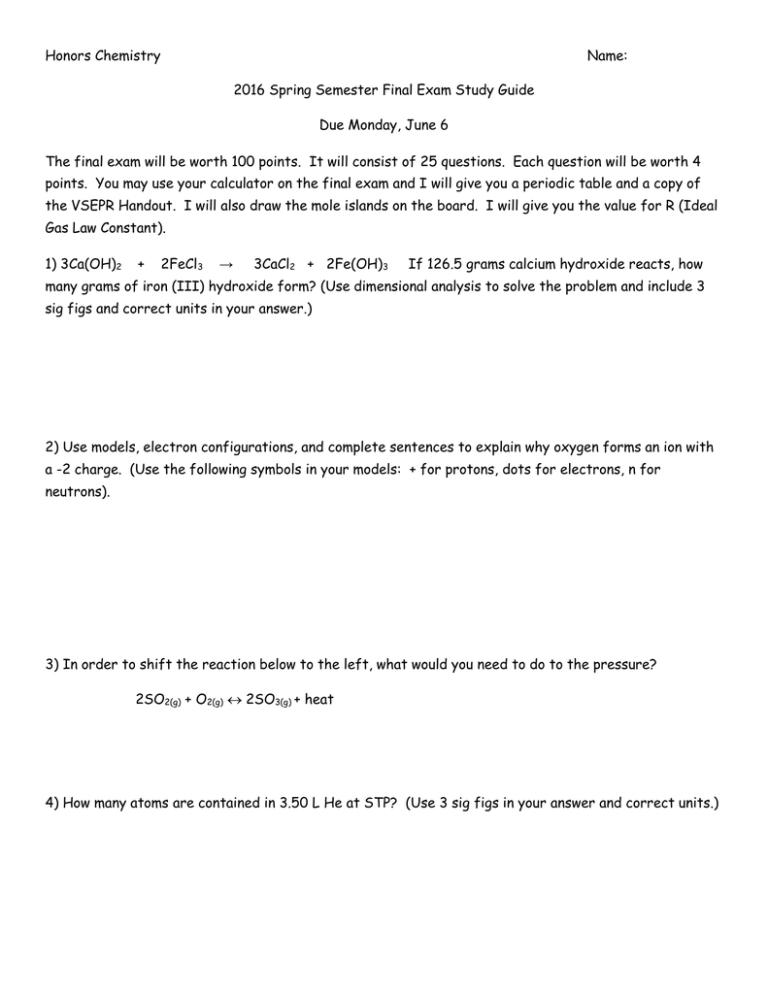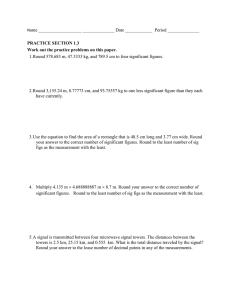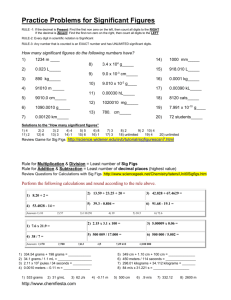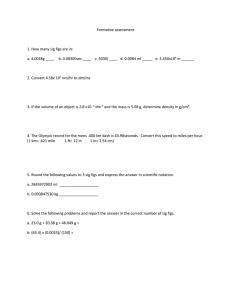Honors Chemistry Name: 2016 Spring Semester Final Exam Study Guide
advertisement

Honors Chemistry Name: 2016 Spring Semester Final Exam Study Guide Due Monday, June 6 The final exam will be worth 100 points. It will consist of 25 questions. Each question will be worth 4 points. You may use your calculator on the final exam and I will give you a periodic table and a copy of the VSEPR Handout. I will also draw the mole islands on the board. I will give you the value for R (Ideal Gas Law Constant). 1) 3Ca(OH)2 + 2FeCl3 → 3CaCl2 + 2Fe(OH)3 If 126.5 grams calcium hydroxide reacts, how many grams of iron (III) hydroxide form? (Use dimensional analysis to solve the problem and include 3 sig figs and correct units in your answer.) 2) Use models, electron configurations, and complete sentences to explain why oxygen forms an ion with a -2 charge. (Use the following symbols in your models: + for protons, dots for electrons, n for neutrons). 3) In order to shift the reaction below to the left, what would you need to do to the pressure? 2SO2(g) + O2(g) 2SO3(g) + heat 4) How many atoms are contained in 3.50 L He at STP? (Use 3 sig figs in your answer and correct units.) 5) A sample of calcium chloride has a mass of 25.8 g. How many molecules of calcium chloride is this? (Use 3 sig figs in your answer and correct units.) 6) What is the molarity of a solution that contains 25.5 grams of potassium sulfate, dissolved in 1000. mL of solution? (Be sure to show your work and include units. Your answer should have 3 sig figs.) 7) Use models and complete sentences to explain why hydrogen-2 and hydrogen-3 are isotopes. (Use the following symbols in your models: + for protons, dots for electrons, n for neutrons). 8) How many grams of water would require 8.20 x 104 calories of heat to raise its temperature from 44.0 °C to 100.0 °C? (Remember the specific heat of water is 1.00 cal/g ◦°C) (Use 3 sig figs in your answer and correct units.) 9) A piece of wood found in an ancient burial mound contains only half as much carbon-14 as a piece of wood cut from a living tree growing nearby. If the half-life for carbon-14 is 5730 years, the estimated age of the ancient wood is_______________. 10) A sample contains 120 g of radioactive material. After 2 half-lives, how much of the original sample will remain? 11) Write a balanced equation for the following process: Polonium-210 produces an α-particle. 12) Write a balanced equation for the nuclear reaction in which Th-234 produces a β-particle. 13) Use words and pictures to show how changes to the composition of the nucleus differ for alpha and beta decay. 14) The temperature of a fixed amount of hydrogen gas is reduced from 125°C to -125°C at constant pressure. If the original volume of gas was 975 mL what was the final volume? (Be sure to show your work and include units. Your answer should have 3 sig figs.) 15) 15.0 grams of glucose is dissolved in 60.0 g water. What is the concentration of the solution, expressed as percent glucose by mass? (Use 3 sig figs in your answer.) 16) An atom has 6 valence electrons. Use words, pictures, and electron configurations to show the number of electrons it needs to lose or gain in order to be stable. 17) A teacher decided to see if the number of homework problems assigned from a chapter had an effect on chapter test scores. Identify the dependent variable in the teacher’s experiment: Identify the independent variable in the teacher’s experiment: Describe a control variable the teacher should have: 18) Draw a Lewis Structure for OCN. Include resonance structures if applicable. Also predict the molecular structure and hybridization. 19) Write the balanced equation for the neutralization reaction with sodium hydroxide and hydrochloric acid (HCl). 20) Use words and graphs to differentiate between endothermic and exothermic reactions. 21) C(g) + Y(g) ↔ 3B(g) + heat The above reaction is a hypothetical reaction where Y is a bright yellow, C is colorless, and B is a bright blue color. What color will the solution be after each of the following changes is made to the system? Adding more C: Cooling the solution: Removing B from the system: 22) The half-life of a sample is 4 minutes. How long will it take for 75% of the sample to decay? 23) Use the data below to explain why the student did or did not meet the purpose: Purpose: Design an experiment (using baking soda and vinegar) that supports the law of conservation of mass. Data: Mass of Cup + Vinegar Mass of Bag + Baking Soda Mass of Bag + Product of Reaction Mass of Cup 54.5 g 15.4 g 45.5 g 24.4 g 24) Read the excerpt from the article. Would the author agree or disagree with the statement, “Different types of candies use different kinds of sugars to make the crystal size different” Underline the 1 sentence from the excerpt that BEST supports your answer. “To make most types of candies, you always start by dissolving sugar in boiling water. This forms a sugar syrup, which you can cool down by taking it off the burner. But how you cool down the syrup can make all the difference. For instance, if you want to make rock candy, you need to let the syrup slowly cool down over many days until big sugar crystals form. But if you want to produce fudge, you need to continuously stir the syrup after an initial cooling period, so when the sugar crystals form, they stay small and do not grow too much. If you want to make cotton candy and glass candy, you need to cool the syrup quickly to keep crystals from forming.” (ChemMatters) 25) List 2 characteristics for each of the following families of elements: Alkali Metals: Halogens: Transition Metals: Noble Gases:




